
Castle Colditz is a Renaissance castle in the town of Colditz near Leipzig, Dresden and Chemnitz in the state of Saxony in Germany. The castle is between the towns of Hartha and Grimma on a hill spur over the river Zwickauer Mulde, a tributary of the River Elbe. It had the first wildlife park in Germany when, during 1523, the castle park was converted into one of the largest menageries in Europe. The castle gained international infamy as the site of Oflag IV-C, a prisoner-of-war camp during World War II for "incorrigible" Allied officers who had repeatedly attempted to escape from other camps.
Reinhold Eggers (1890–1974) was the security officer at Oflag IV-C from November 1940 to April 1945, promoted to chief of security in 1944. The Nova television programme Nazi Prison Escape, a shortened cut of a British documentary series, was based on his books about Colditz. He spent 10 years in Soviet-ordered imprisonment following the war and was released in 1955.

Oflag VIII-E was a World War II German prisoner-of-war camp for Allied general officers (Offizierlager) located in Jánské Koupele in German-occupied Czechoslovakia.

Oflag IV-B Koenigstein was a German POW camp for Allied officers during World War II. It was located in Festung Königstein near the town of Königstein in Saxony.
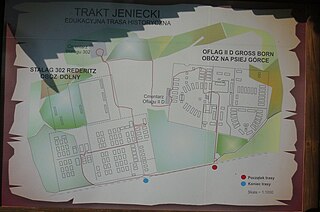
Oflag II-D Gross Born (Grossborn-Westfalenhof) was a World War II German prisoner-of-war camp located at Gross Born, Pomerania, near Westfalenhof (Kłomino). It housed Polish and French officers.
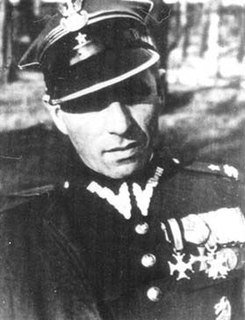
Henryk Sucharski (1898–1946) was a Polish military officer and a major in the Polish Army. At the outbreak of World War II, he was one of the commanders of the Westerplatte position in Danzig, which troops under his command defended for seven days against overwhelming odds. Sucharski survived the war.

Oflag VI-B was a World War II German prisoner-of-war camp for officers (Offizerlager), 1 km (0.6 mi) southwest of the village of Dössel in Germany.
Oflag IX-C was a German prisoner-of-war camp for officers (Offizierlager) during World War II, located just to the south of the village of Molsdorf, near Erfurt in Thuringia.
Oflag VII-B was a World War II German prisoner-of-war camp for officers (Offizierlager), located in Eichstätt, Bavaria, about 100 km (62 mi) north of Munich.
Oflag X-B was a World War II German prisoner-of-war camp for officers (Offizierlager) located in Nienburg am Weser, Lower Saxony, in north-western Germany. Adjacent to it was the enlisted men's camp (Stammlager) Stalag X-C.

Stalag VI-C was a World War II German POW camp located 6 km west of the village Oberlangen in Emsland in north-western Germany. It was originally built with five others in the same marshland area as a prison camp (Straflager) for Germans. From 1939 till 1945 the Oberlangen camp was a Prisoner of War camp.

Camp Fünfeichen was a World War II German prisoner-of-war camp located in Fünfeichen, a former estate within the city limits of Neubrandenburg, Mecklenburg, northern Germany. Built as Stalag II-A Neubrandenburg in 1939, it was extended by the officer camp Oflag II-E in 1940. After the Soviet takeover in 1945 until 1949 it was used as special camp, NKVD-camp Nr. 9 of the Soviet secret service (NKVD). Today, the site of the camp is a memorial.

Oflag IV-C, often referred to by its location at Colditz Castle, overlooking Colditz, Saxony, was one of the most noted German Army prisoner-of-war camps for captured enemy officers during World War II; Oflag is a shortening of Offizierslager, meaning "officers' camp".
Stalag IV-A Elsterhorst was a World War II German Army prisoner-of-war camp located south of the village of Elsterhorst, near Hoyerswerda in Saxony, 44 kilometres (27 mi) north-east of Dresden.

Oflag VII-C was a World War II German prisoner-of-war camp for officers located in Laufen Castle, in Laufen in south-eastern Bavaria from 1940 to 1942. Most of the prisoners were British officers captured during the Battle of France in 1940. To relieve overcrowding, some of the officers were transferred to Oflag VII-C/Z in Tittmoning Castle. The Oflag existed only for a short time. In early 1942 all the officers were transferred to Oflag VII-B in Eichstätt.
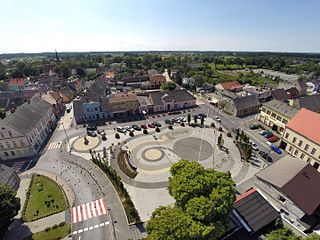
Szubin is a town in Nakło County, Kuyavian-Pomeranian Voivodeship, Poland, located southwest of Bydgoszcz. It has a population of around 9,300. It is located in the ethnocultural region of Pałuki.
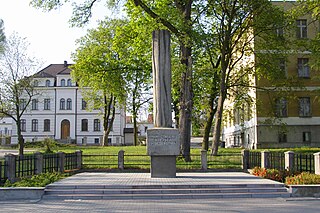
Oflag XXI-B and Stalag XXI-B were World War II German prisoner-of-war camps for officers and enlisted men, located at Szubin a few miles southwest of Bydgoszcz, Poland, which at that time was occupied by Nazi Germany.
Machiel van den Heuvel was a Dutch army officer. As a prisoner-of-war in Oflag IV-C at Colditz Castle, Germany, during World War II, he served as Escape Officer for the Dutch POWs, a role also held by Captain Pat Reid, the author of The Colditz Story, for the British. Van den Heuvel played a key role in most Dutch officer escapes during the war.
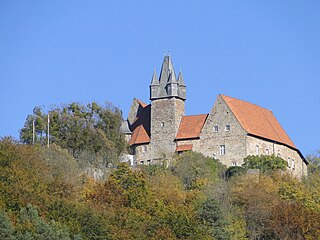
Oflag IX-A was a World War II German prisoner-of-war camp located in Spangenberg Castle in the small town of Spangenberg in northeastern Hesse, Germany.

Nazi Germany operated around 1,000 prisoner-of-war camps during World War II (1939-1945).















